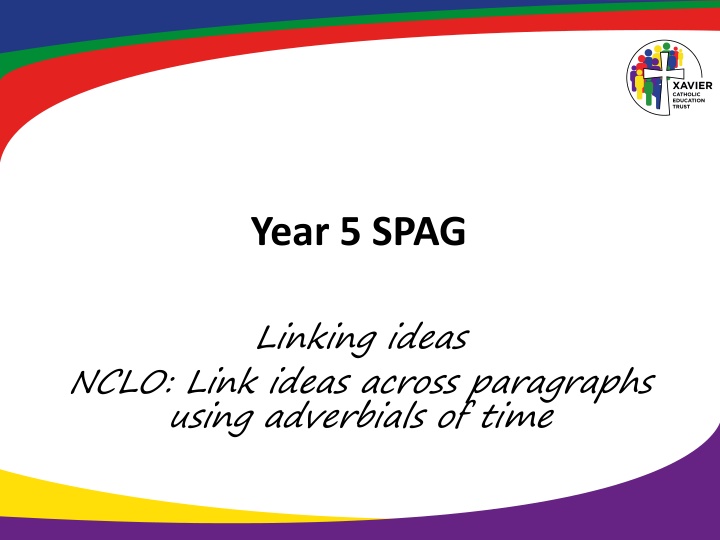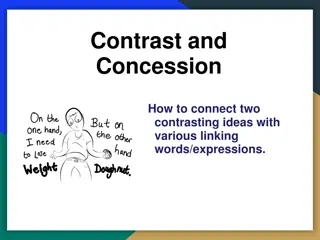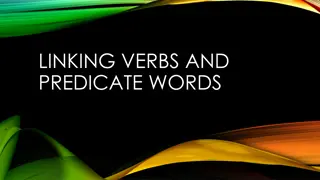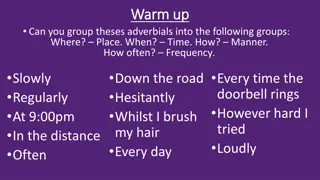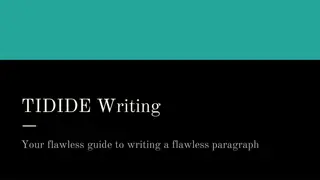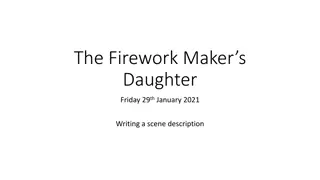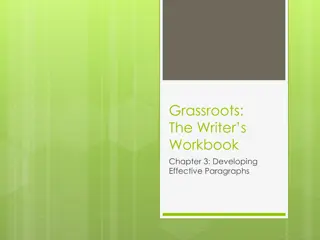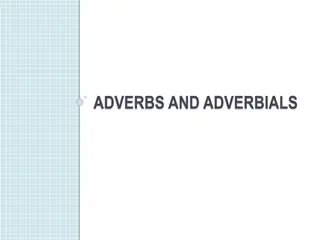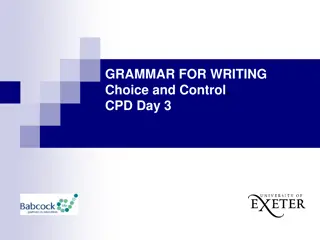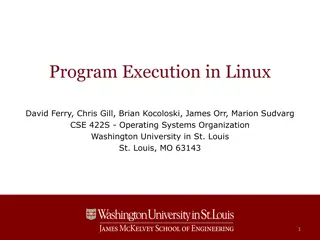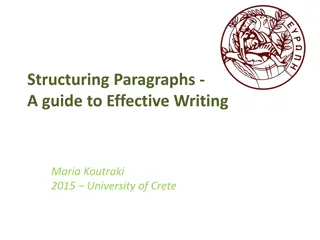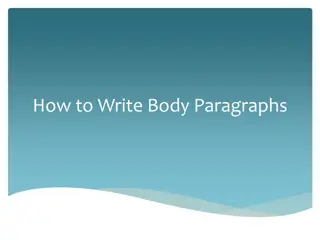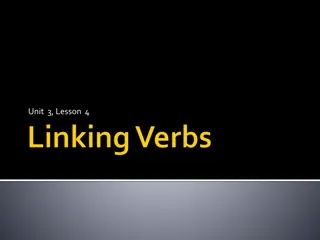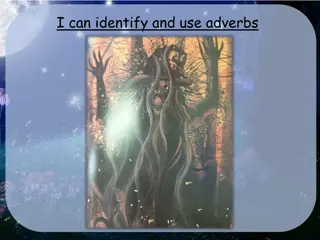Enhancing Writing Flow with Adverbials of Time and Frequency in Linking Ideas Across Paragraphs
Explore how adverbials of time and frequency can be used to link ideas across paragraphs, as demonstrated in the writing piece "Making Honey." Learn how deliberate word choices can help connect sentences and maintain coherence in writing.
Download Presentation

Please find below an Image/Link to download the presentation.
The content on the website is provided AS IS for your information and personal use only. It may not be sold, licensed, or shared on other websites without obtaining consent from the author.If you encounter any issues during the download, it is possible that the publisher has removed the file from their server.
You are allowed to download the files provided on this website for personal or commercial use, subject to the condition that they are used lawfully. All files are the property of their respective owners.
The content on the website is provided AS IS for your information and personal use only. It may not be sold, licensed, or shared on other websites without obtaining consent from the author.
E N D
Presentation Transcript
Year 5 SPAG Linking ideas NCLO: Link ideas across paragraphs using adverbials of time
Link ideas across paragraphs using adverbials of time Can you provide a definition for the word paragraph in 15 words?
A paragraph is a group of sentences that is separate when you remember, do one. A paragraph is a group of 3 or more sentences which share a common theme. Which of these do you think is best? Or do you prefer your own? A paragraph is a self- contained unit of writing concerned with examining a particular point or idea.
Once you have mastered forming paragraphs effectively, you can begin to think about how to link your ideas across them in order to help your writing flow. If you spend some time thinking about how to begin your new paragraph, you can deliberately choose words which will link the sentences in your new paragraph to the ideas you set out in the previous paragraph. Doing this makes it clear to the reader that you are in control of the subject you are writing about!
Lets see how the author of Making Honey could have used adverbials to link paragraphs. In the piece of writing entitled Making Honey the author could have linked the paragraphs with adverbs of time. Adverbs of time answer the question: When? Bees eat honey and they start making it by visiting flowers. They collect nectar, which is a sugary liquid, from the blossom by sucking it out. They store it in their honey stomachs which are separate to their other stomachs. When their stomachs are full, they fly back to the hive. When they get there, they pass the nectar to worker bees who chew it and then pass it to the next bee. As it passes from bee to bee, it gradually turns into honey. Until they need to eat it, the bees store the honey in honeycomb cells basically tiny jars made of wax. Because the honey is wet, they fan it with their wings to make it stickier. To keep it clean, they seal the cell with a wax lid. How do these adverbials link the ideas across the paragraphs?
In the piece of writing entitled Making Honey the author could also have linked the paragraphs with adverbs of frequency. Adverbs of frequency answer the question: How often? Normally, bees eat honey and they start making it by visiting flowers. They collect nectar, which is a sugary liquid, from the blossom by sucking it out. They store it in their honey stomachs which are separate to their other stomachs. Every time their stomachs are full, they fly back to the hive. When they get there, they pass the nectar to worker bees who chew it and then pass it to the next bee. As it passes from bee to bee, it gradually turns into honey. Usually the bees store the honey in honeycomb cells basically tiny jars made of wax. Because the honey is wet, they fan it with their wings to make it stickier. To keep it clean, they seal the cell with a wax lid. How do these adverbials link the ideas across the paragraphs?
How do adverbials of place differ from prepositions? Prepositions require an object Adverbials of place do not Under the rock was a message. Inside there were long shadows. Over the bridge was the safest route. Nearbywas the dragon s cave.
In the piece of writing entitled Making Honey the author could have linked the paragraphs with adverbs of number. Adverbs of number answer the question: In what order? Firstly, Bees visit flowers in order to make the honey that they eat. They collect nectar, which is a sugary liquid, from the blossom by sucking it out. They store it in their honey stomachs which are separate to their other stomachs. Secondly, stomachs fill up and they fly back to the hive. They get there, pass the nectar to worker bees who chew it and then pass it to the next bee. As it passes from bee to bee, it gradually turns into honey. Finally, the bees store the honey in honeycomb cells basically tiny jars made of wax. Because the honey is wet, they fan it with their wings to make it stickier. To keep it clean, they seal the cell with a wax lid. How do these adverbials link the ideas across the paragraphs?
Keeping tenses consistent in a specific frame of reference can also link ideas Making choices about tenses can also link your paragraphs by ensuring that references bridge the gap between paragraphs. An example is given here She had brown hair and blue eyes, which was unusual. She performed for 12 hours straight. People wondered how she didn t stop. He had seen her before. She had been younger then and so had he. He wanted to be the record holder. That s why he had practised for so long. He knew he could do it. He might well have done it if it wasn t for the dog Referring back to an aspect of the previous paragraph and making the right tense choice will effectively link ideas. Have a practice what could the first sentence of the next paragraph to follow this one be? The best thing about the day had been the rides. It was pure joy to relax and be thrown this way and that. There were so many to choose from.
In What Order? When? How Often? Where? Which of the following words answer the questions In what order? , When? , How often? and Where? . Some of the words may answer more than one question in these cases try to choose the best fit. Draw a table in your book. Which of the following words answer the questions In what order? , When? , How often? and Where? . Some of the words may answer more than one question in these cases try to choose the best fit. In what order? When? When? How often? Where? later over sometimes instantly normally usually recently nowhere outside after once on regularly under anywhere firstly secondly already twice below often whenever occasionally never finally tomorrow frequently nearby before always rarely simultaneously next hardly ever thirdly behind
Here are some suggested possible answers. In what order? How often? Where? firstly secondly thirdly next once twice simultaneously finally after regularly usually often sometimes rarely frequently hardly ever normally occasionally always over under behind below anywhere nearby outside on nowhere When? already recently tomorrow before never whenever later instantly
Find yourself a reading book in the classroom or use your own. Hunt down the words that begin each of the paragraphs. This is easy to do because the paragraphs are likely to be indented (The way the first line of a paragraph is set in from the margin.) Write down any adverbs used to link paragraphs which answer the question When? Where? or How Often? and make a note of each individual example you find. You can decide if a word belongs to one of the groups by asking the question and trying to answer it with the word you have found. E.g. When? Yesterday.
How often? In what order? When? Where? inside about below firstly once finally while yesterday meanwhile soon immediately never occasionally
Decide which adverb of time to use to link each pair of paragraphs together. 1. Decide which adverb of time to use to link each pair of paragraphs together. before soon when now The tiny cheetah cub was captured and brought to the zoo. He was fed with milk and watched day and night. The cub was called Simba and was not put on display at first. __________________ visitors were able to see him. Simba began to eat solid food and wash himself. He was introduced to the other cheetahs at the zoo.
Decide which adverb of time to use to link each pair of paragraphs together. 1. Decide which adverb of time to use to link each pair of paragraphs together. before soon when now The swimming pool was muddy and murky and covered with floating leaves. There was thick gunge on the side walls. A cleaning company was called in to help. _________________ long the pool looked as good as new. The water was sparkling, shimmering and clear. Time to party!
Decide which adverb of time to use to link each pair of paragraphs together. 1. Decide which adverb of time to use to link each pair of paragraphs together. before soon when now Mary was worried the bus would be late. She kept checking her watch every five minutes. If she missed it, the day would be ruined. ___________ she looked up and saw the bus, Mary was filled with relief. She climbed on the bus and sat herself by a window to enjoy the journey.
Decide which adverb of time to use to link each pair of paragraphs together. 1. Decide which adverb of time to use to link each pair of paragraphs together. before soon when now The weather has been icy and cold. The schools have been closed. Even the children have stayed inside. _____________ this is set to change. Tomorrow the sun will shine and the snow will disappear. It will feel as though winter is over.
2. Decide which adverb of frequency to use to link each set of two paragraphs together. often usually occasionally sometimes Making a TV programme is fairly simple. Everybody works through the scenes building the set and preparing the costumes. The filming begins and the actors and presenters need to get their lines right! _______ there is a delay between the filming and the show being on TV. The pictures need to be edited and any sound effects and credits added. Sometimes some scences will need reshooting.
2. Decide which adverb of frequency to use to link each set of two paragraphs together. often usually occasionally sometimes Athletes train all through the year but focus on one competition. They build up their fitness by choosing events to take part in. Every detail is planned. ______________ athletes will rest in the weeks before a big event. They will train less and relax more. They try to make sure they have plenty of energy for the big event.
2. Decide which adverb of frequency to use to link each set of two paragraphs together. often usually occasionally sometimes Lots of machines are used in factories. Machines are cheaper to run then people. Some factories even use machines instead of cleaners. _______________ a machine will break down. When this happens a human is required to fix the problem. Broken machines can cause money to be wasted if the problem is not fixed quickly.
2. Decide which adverb of frequency to use to link each set of two paragraphs together. often usually occasionally sometimes Metal detecting is a popular hobby. Some people spend hours of their spare time hunting for metal. They hope to get rich or to find important objects from history. ______________ metal detectors find something really special. In these cases there are rules about what people are allowed to keep. We do not know if some metal detectors have found treasure which people have kept secret.
2. Decide which adverb of place to use to link each set of two paragraphs together. anywhere below outside nearby Metal detecting is a popular hobby. Some people spend hours of their spare time hunting for metal. They hope to get rich or to find important objects from history. ______________ metal detectors find something really special. In these cases there are rules about what people are allowed to keep. We do not know if some metal detectors have found treasure which people have kept secret.
